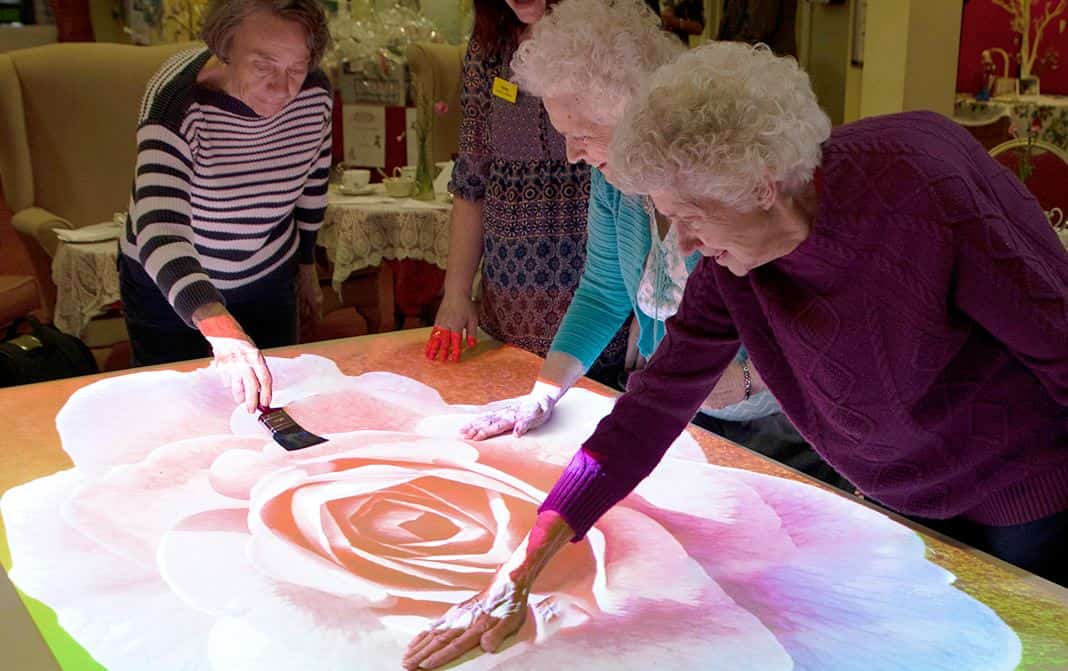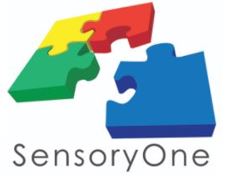
As published in Canadian Health Technology, Sept 2020.
(Photo does not depict residents of Lanark Heights Long Term Care but seniors at another unidentified facility)
KITCHENER, ONT. – A grey-haired woman slowly shuffles her walker toward a huddle of giggling residents. Her face is blank when she notices that her peers are sweeping their arms across a large black and white projection of spring flowers on a tabletop.
Magically, the flowers are turning vibrant colours with each pass of an elderly hand.
Within a minute of observation the woman joins in and begins moving her arms to “paint” flowers too. She smiles as she reaches and waves her arms across the tabletop. Her normally stiff limbs relax and her body flows as she enjoys the group activity.
A scene like this no longer surprises Hildy Nickel, administrator of the Lanark Heights Long Term Care facility in Kitchener, Ont. In fact, she has seen it enacted multiple times since her facility introduced the Mobii Magic Surface to its 160 residents two years ago.
“The Mobii is fun for our residents, and it involves more movement than most of our other activity offerings,” says Nickel, who likes to stay current with the latest technology. “We offer exercise programs, colouring, puzzles and many other activities. But the Mobii is something different that always creates spontaneous smiles and laughter.”
The Mobii is a small, self-contained portable projector that houses a wealth of rich and stimulating activities for older adults, including those with dementia. The motion-activated, interactive tool uses images, games, quizzes, colour and music to evoke memories, stimulate conversation and encourage physical activity.
The technology makes it enjoyable and easy for people to move their bodies and to interact with the world around them. It also allows them to have some control over their environment.
Designed by sensory technology company OM Interactive, and winner in the Outstanding Dementia Product category in the U.K.’s Dementia Care Awards, the Mobii can be easily wheeled directly to groups of residents in communal areas or to individual bed-bound residents. Images can be projected onto a tabletop or onto the floor for larger groups and games.
The floor projection is ideal for those who are able to ambulate. For example, they can walk or wheel across a virtual nature trail, scattering leaves along the way. Non-ambulatory residents can enjoy the same experience using their feet from a seated position.
Its versatility is appreciated by staff members. They can adjust the volume, control the object speed, and easily create custom content with photos of family members or special events.
Residents can push tiny seashells, resting in shallow tropical water, into a pile. They can watch the water ripple and listen to the sounds of the sea.
Or toss a beanbag into a puddle. Watch and hear the splashes.
They might wipe away the image of an old-fashioned candy shop with a hand or baton to reveal childhood sweets, or use a feather duster to wipe away steam and reveal a train with actual family members peering out the windows.
They can tap on moving eggs and crack them open, using hands, feet, a cane or a walker.
Care homes report that while the physical activity and powerful visuals help improve their residents’ physical fitness, they also reduce apathy, stress and anxiety.
With the Mobii, these visuals can include greenery, birds, trees and gardens. Research shows that nature experiences – even virtual versions – can boost emotional well-being and awaken feelings of happiness and peace.
For family members, interacting with the Mobii helps remove the pressure of struggling to make conversation with an elderly loved one. Family visits are more exciting for everyone when they know that they can play together with the Mobii.
A 2018 research study of 89 care homes in the U.K. found that 96 percent of respondents would recommend the Mobii. Additional findings showed that:
- 90 percent of respondents felt the Mobii had a positive impact on their residents’ physical ability, participation and movements; and
- 75 percent felt the Mobii had helped their most withdrawn residents
General survey comments were equally enthusiastic: “Our residents love it!” “Their lives are more fulfilled.” “They don’t notice they’re being physically active.” “It brings residents out of themselves.” “It’s great to see them interacting with each other.”
There is a current move away from the idea that long-term care homes are solely medical treatment centres.
“Stimulating and engaging all older adults, especially those living with dementia, with meaningful person-centered activities is so important in care homes, centres and hospital settings,” said Gwen Rose, vice-president of Toronto-based Sensory One, and North American distributor of the Mobii Magic Surface and other innovative and unique sensory products.
“There’s a strong move toward an emotion- based model of care, which focuses on the idea that a long-term care home is a resident’s home,” said Rose, who practised as a physiotherapist in long-term care for over 14 years. “With this model, there’s an added focus, beyond providing basic care, of helping people to live well by giving them a sense of belonging and opportunities for vibrancy. The Mobii stimulates physical, cognitive and social engagement and contributes to emotional well-being.”
At Lanark, staff members particularly appreciate the Mobii’s portability and versatility.
“If a resident is having a tough day, they can easily take the Mobii directly to that person and then have dozens of activity options to choose from,” says Nickel.
It helps staff members more easily make a connection with residents by stimulating conversation, activity and fond memories. For withdrawn residents, it encourages them to interact and communicate with others.
And at Lanark, it is not just the residents who are benefiting from the technology.
“We’ve included the Mobii in family council meetings, a staff holiday luncheon, and several other staff events,” Nickel says.



